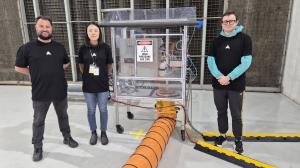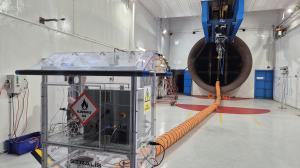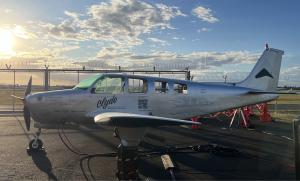Stralis Aircraft advances groundbreaking hydrogen fuel cell technology in Auckland test facility
Stralis Aircraft advances testing of groundbreaking hydrogen fuel cell technology in Air New Zealand's Auckland test facility
BRISBANE AIRPORT, QLD, AUSTRALIA, September 23, 2025 /EINPresswire.com/ -- • Stralis Aircraft is testing groundbreaking high-temperature fuel cell technology that will power emission free, cost effective and quieter aircraft in the future.
• Stralis Aircraft has been working with Air New Zealand, Hiringa Energy and the NZ Product Accelerator to set up and undertake the testing in Air New Zealand’s engine test cell facility at Auckland Airport
• The testing will collect performance data that will help Stralis understand degradation rates to support a credible lifetime assessment for the fuel cell system product.
Australian clean-tech startup Stralis Aircraft is testing its groundbreaking high-temperature fuel cell technology in an Auckland test facility, to help enable Australasia’s first hydrogen-electric flights. Working with the support of Air New Zealand, the NZ Product Accelerator hosted by University of Auckland and Hiringa Energy, hydrogen fuel cell testing has been made possible.
Stralis Aircraft is developing fuel cells to power high-performance, low operating cost, hydrogen-electric propulsion systems for aircraft and other heavy transport applications. Their proprietary high temperature PEM fuel-cell technology is significantly lighter than existing alternatives, enabling aircraft to fly ten times further than battery-electric solutions at a lower cost than fossil-fuel-powered planes. The company is already testing its fuel cells in the U.S. but has now started testing closer to home in New Zealand.
The testing will provide data that will help Stralis understand degradation mechanisms and degradation rates to support a credible lifetime assessment for the fuel cell system product. Achieving long life HTPEM fuel cells is important to deliver engine maintenance cost savings to airline customers. This measured data will help quantify maintenance savings and encourage adoption of the technology.
Stralis’s propulsion technology delivers significant benefits: zero emissions (producing only water vapour), up to 50% lower operating costs, and reduced noise. Their system integrates their fuel cells, liquid hydrogen tanks, and electric motors into existing and new aircraft designs, and plans to achieve the first flight of its six-seat Bonanza A36 technology demonstrator aircraft later this year in Queensland, Australia.
Stuart Johnstone, co-founder and CTO of Stralis Aircraft says “We are proud to be working with Air New Zealand to test our unique fuel cell technology in their engine test facility at Auckland Airport. New Zealand is an ideal location to develop, test and adopt emission free aircraft technology, so it is a great place to build capability and understanding. The test cell is attractive because it has lots of capacity to grow and enable testing of our higher power systems. It is great to be working with businesses in Australasia to make hydrogen-electric and zero-emission aviation a reality. With the help of our Kiwi partners, we have managed to get the test cell operational in “record” time”.
Matthew Connolly, Air New Zealand’s Sustainability Lead Energy Transition, says “Across Air New Zealand we have a significant programme dedicated to preparing for the future of flight, and the energy transition is a critical part of this work. That’s where opening the engine test cell facility to innovative companies such as Stralis comes in, as another step in our collective learning about new technologies, future engine propulsion, and new ways that aircraft will fly people and goods in a lower-carbon future. We believe Sustainable Aviation Fuel (SAF), hydrogen and electricity will all be critical parts of a future aviation eco-system, and we’re proud to be supporting the innovation that Stralis is testing here in New Zealand.”
Hydrogen-electric propulsion systems have fewer moving parts and operate at lower temperatures compared to existing aircraft engines, which is predicted to reduce engine maintenance costs by between 40-60%. This is similar to the maintenance cost reductions seen between combustion engine and electric cars. The hydrogen stored onboard in a tank, powers a fuel cell that generates electricity to power an electric motor, that drives a propellor. Hydrogen-electric propulsion systems can be used for aircraft battery replacement, retrofit airframes, new clean sheet designs or even as auxiliary power units (APUs) onboard larger aircraft.
END
More information for editors:
More than 190 countries, including Australia and New Zealand, have agreed to target net zero carbon emissions from aviation in 2050. By the mid 2030’s, the sector needs to be actively deploying zero emission technologies and solutions. One solution that can genuinely reduce CO2 and non-CO2 emissions is hydrogen-electric propulsion. The only emission released from a hydrogen-electric fuel cell powertrain is water.
Green hydrogen is produced through electrolysis of water using renewable electricity. Hydrogen’s energy density is three times higher than kerosene and sustainable aviation fuel (SAF), and it is over 100 times higher than batteries, with a relatively fast refuelling capability when using liquid hydrogen. In the last five years, the aviation sector has turned to hydrogen as a credible alternative fuel to reduce emissions, costs and noise, although it has been flown in multiple demonstrator aircraft globally since 1957.
Stralis is developing a hydrogen electric propulsion system in which electricity is supplied to an electric propeller motor via a fuel cell. The system generates power through the electrochemical reaction of hydrogen and oxygen (from ambient air) within a fuel cell stack. However, current commercially available fuel cell systems remain too heavy to meet the strict performance and weight requirements of commercial aviation. Stralis is developing a novel lightweight fuel cell based around a new type of high temperature membrane, which allows Stralis to achieve higher propulsion system specific power making it suitable. If Stralis meets our reasonable cost and lifetime targets, we will be able to cut the operating cost of a 50 seat, propeller driven aircraft in half, compared to today’s Jet Fuel burning turboprop aircraft.
Globally, most domestic aviation services could be serviced by emerging battery electric (short range) and hydrogen-electric (medium range) technologies reducing an estimated 50% of global air travel CO2 emissions that come from flights under 2200km. Considering both emissions reduction and aircraft performance in terms of range and power, hydrogen-electric aircraft offers a credible alternative.
Media Contact
Stralis Aircraft Pty Ltd
411530941 ext.
info@stralis.aero
Visit us on social media:
LinkedIn
Legal Disclaimer:
EIN Presswire provides this news content "as is" without warranty of any kind. We do not accept any responsibility or liability for the accuracy, content, images, videos, licenses, completeness, legality, or reliability of the information contained in this article. If you have any complaints or copyright issues related to this article, kindly contact the author above.



